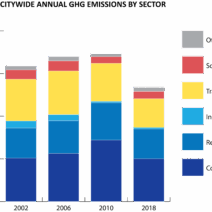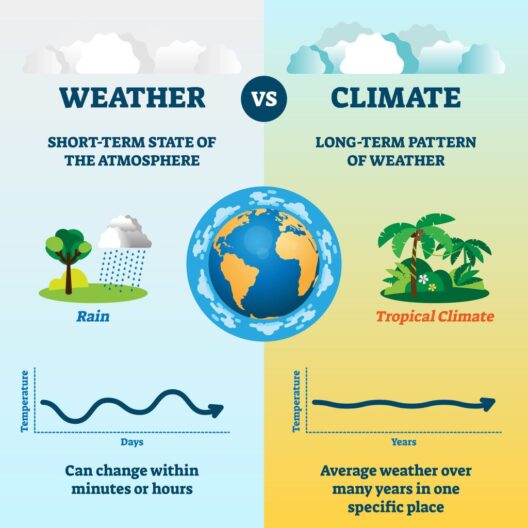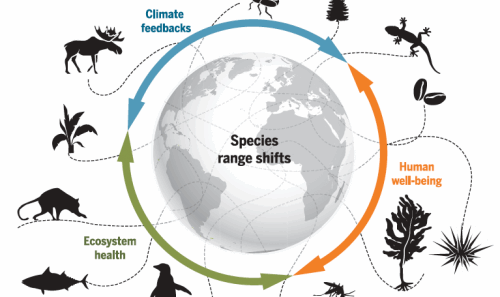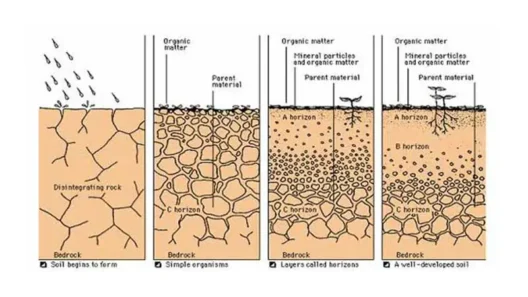Climate is a fundamental concept that encompasses the intricate patterns governing the Earth’s long-term weather conditions. Distinct from weather, which represents the short-term state of the atmosphere at a specific place and time, climate is characterized by the accumulation of weather data over extended periods—typically 30 years or more. This nuanced understanding forms the bedrock of climatology, a scientific discipline that examines the complex interactions among atmospheric components, land surfaces, oceanic systems, and human activities. To elucidate the essence of climate, it is imperative to explore its definitions, classifications, and implications on various facets of life on Earth.
Understanding climate requires a comprehensive grasp of its various components, such as temperature, precipitation, humidity, wind patterns, and atmospheric pressure. These elements collectively define the climatic characteristics of a particular region, helping to classify it into specific climate zones, such as tropical, arid, temperate, or polar. By examining these variables in unison, climatologists can ascertain the average conditions that prevail over decades and share insights on potential future scenarios.
The classification of climates often leans on established taxonomy systems; one prevalent framework is the Köppen climate classification, devised by climatologist Wladimir Köppen in the early 20th century. This system categorizes climates based on geographical distribution of vegetation and temperature, utilizing letters to depict distinct climates: ‘A’ for tropical, ‘B’ for arid (deserts), ‘C’ for temperate, ‘D’ for continental, and ‘E’ for polar. Each category addresses the temperature range and precipitation patterns characteristic of areas across the globe, revealing an interconnected tapestry reflective of human behest, flora, and fauna.
Another essential aspect to consider is the concept of microclimates—localized atmospheric zones where conditions differ significantly from the surrounding areas. Such microclimates can arise due to variations in elevation, vegetation cover, and proximity to bodies of water. A classic example can be observed in urban environments, where the intensity of human activity and infrastructure creates urban heat islands, resulting in temperature discrepancies between cities and their rural counterparts. This phenomenon underscores the critical, yet often overlooked, implications that localized climate conditions have on ecological balance and urban planning.
The impact of climate reaches far beyond mere atmospheric situations; it exerts significant influence on agriculture, health, water resources, and biodiversity. For instance, shifts in climatic patterns can alter growing seasons, disrupt precipitation cycles, impact crop yields, and render particular regions more susceptible to pests and diseases. Variations in temperature and moisture levels can also provoke extreme weather events, such as droughts, floods, hurricanes, and blizzards, with grave consequences for communities and economies.
Moreover, climate change—a relatively contemporary phenomenon—further complicates the traditional understanding of climate. Human activities, particularly the burning of fossil fuels, deforestation, and industrial processes, have augmented concentrations of greenhouse gases in the atmosphere. These alterations may lead to an unprecedented acceleration of climate anomalies, where a region’s inherent climatic traits undergo radical transformations. The ramifications of climate change manifest as rising sea levels, melting glaciers, shifting habitats, and the expansion of arid zones, challenging the resilience of both ecological and human systems.
In addition to the physical and biological dimensions of climate, there exists an undeniable socio-political aspect. Questions surrounding climate equity, climate justice, and adaptive capacity are increasingly prominent within global dialogues. Developing nations disproportionately bear the brunt of climate-related adversities, despite contributing minimally to greenhouse gas emissions. Consequently, there is a pressing urgency to address these disparities through collaborative efforts focused on mitigating climate impacts and investing in sustainable development strategies that prioritize the most vulnerable populations.
Furthermore, public perception of climate plays a pivotal role in shaping policy and discourse. Educational initiatives aimed at disseminating accurate information empower individuals to recognize the urgency of climate action. Social movements advocating for sustainable practices, alongside prominent environmental organizations, mobilize citizens and engage them in conversations that challenge established norms. Incorporating climate education into curricula fosters an informed citizenry better equipped to confront the multifaceted challenges that climate change poses. The public’s understanding of the subject is vital for the implementation of effective policies and practices that safeguard both current and future generations.
In summary, climate is an intricate tapestry woven from myriad atmospheric elements, influenced by temporal and spatial factors. Through the lens of climate classification, microclimates, and the consequences of climate change, one can appreciate the significance of understanding our planet’s long-term weather conditions. Climate impacts each facet of life on Earth. By acknowledging the broader implications of climate, individuals can become advocates for environmental stewardship and sustainable practices that preserve the Earth’s ecosystems for posterity. The future remains contingent upon collective action—both at individual and global levels—essential for confronting the challenges posed by our changing climate.






